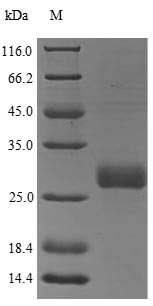Recombinant Rat Oncostatin-M (Osm) is produced using a yeast expression system, which appears to ensure high yields of the full-length mature protein covering amino acids 26-208. The protein comes with an N-terminal 6xHis tag, making purification and detection more straightforward. SDS-PAGE analysis confirms the product displays a purity greater than 85%, though this level seems suitable for various research applications. It's provided as a research-use-only product with no detectable endotoxin levels.
Oncostatin-M (Osm) is a cytokine that likely plays a significant role in regulating inflammation, cell growth, and development across different biological systems. The protein appears to be involved in various signaling pathways, including those that may be critical for immune response modulation and tissue remodeling. Its importance in research stems from its involvement in these complex biological processes, making it a potentially valuable protein for studies in cellular signaling and cytokine interactions.
Potential Applications
Note: The applications listed below are based on what we know about this protein's biological functions, published research, and experience from experts in the field. However, we haven't fully tested all of these applications ourselves yet. We'd recommend running some preliminary tests first to make sure they work for your specific research goals.
Rat OSM is a cytokine that requires precise folding, disulfide bond formation, and proper dimerization for its functional activity through receptor binding. The yeast expression system provides a eukaryotic environment that supports proper protein folding and disulfide bond formation, increasing the probability of correct folding compared to bacterial systems. However, the N-terminal 6xHis tag may potentially interfere with the protein's functional domains or receptor-binding interfaces. While yeast expression provides favorable conditions, experimental validation remains essential to confirm functional activity.
1. Antibody Development and Validation
This application is highly suitable regardless of folding status. Antibody development relies on antigenic sequence recognition rather than functional folding. If correctly folded (verified), the protein excels for generating conformation-sensitive antibodies that recognize native OSM epitopes. If misfolded/unverified, it remains suitable for producing antibodies against linear epitopes, which are still valuable for detection applications.
2. Protein-Protein Interaction Studies
This application requires proper folding validation. Cytokine-receptor interactions depend on precise tertiary and quaternary structure. If correctly folded (verified), the protein is suitable for identifying physiological interaction partners with OSM receptors (OSMRβ/gp130). If misfolded/unverified, there is a high risk of non-specific binding or failure to identify genuine interactions.
3. Comparative Species Analysis
This application depends on correct folding validation. Meaningful comparative studies require native protein conformation. If correctly folded (verified), the protein enables valid cross-species comparisons of structural and functional properties. If misfolded/unverified, comparative analyses would yield misleading results as differences may reflect misfolding rather than genuine species variations.
4. Biochemical Characterization and Stability Studies
These studies are essential for determining folding status regardless of functional state. If correctly folded (verified), characterization provides reliable data on dimerization, stability, and structural properties. If misfolded/unverified, analysis yields valuable physical property data for this specific preparation.
Final Recommendation & Action Plan
The yeast expression system provides favorable folding conditions for this cytokine, but experimental validation of structural integrity and functional activity is essential before reliable use in biological studies. Begin with Application 4 (Biochemical Characterization) to assess folding quality through size-exclusion chromatography (dimerization check), circular dichroism spectroscopy, and thermal stability assays. If correct folding is verified, proceed to validate functional activity through receptor binding assays. Once folding and activity are confirmed, proceed cautiously with Applications 2 and 3 for interaction studies and comparative analyses. Application 1 (antibody development) can proceed immediately regardless of folding status. If misfolding is detected, limit applications to linear epitope antibody production and basic biophysical characterization, avoiding all functional interaction and comparative studies. For reliable OSM research, always include appropriate activity controls and consider using mammalian-expressed protein for critical functional assays.






